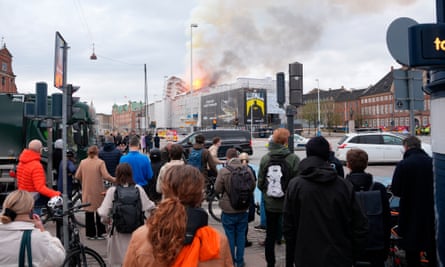Firefighters at Copenhagen’s historic former stock exchange have been battling a huge blaze that has engulfed the 17th-century building’s roof, toppled its distinctive spire and threatened one of Denmark’s most valuable art collections.
“We are witnessing a terrible spectacle. The Bourse is on fire,” the Chamber of Commerce, which occupies the building next to Christiansborg Palace, the seat of the Danish parliament, wrote on X. “Everyone is asked to stay away.”
Dramatic footage showed huge plumes of black smoke rising from the Dutch Renaissance-style building, which was undergoing renovation and clad in scaffolding. Police said they had blocked off a main road and part of the city centre.
Copenhagen’s fire service said the blaze was reported at 7.30am. The extensive scaffolding around the building was making it significantly harder to tackle the flames, it said, while the Bourse’s copper roof was trapping the heat.
“The extinguishing work is very difficult,” said a fire service spokesperson, Jakob Vedsted Andersen, adding that there were substantial areas of the building that firefighters could not yet access because it was too dangerous.
Parts of the roof had collapsed and the fire had spread to several floors, Vedsted said. About 120 people were fighting the fire but only about 40% of it was under control and the operation was expected to continue for at least 24 hours, he said.
About 90 conscripts from the Royal Life Guards, an army unit, were also helping to cordon off the site and secure valuables inside, local media reported.
The Bourse, commissioned by King Christian IV and built between 1619 and 1640, was topped by a 56-metre (184ft) spire in the shape of the tails of four dragons entwined. The building housed Denmark’s stock exchange until 1974.
The dragons on the roof were seen as symbolically protecting the exchange from enemies, as well as from fire, the Chamber of Commerce said on its website. The spire also had three crowns at the top, symbolising the kingdoms of Denmark, Norway and Sweden.
Ulla Kjaer, a senior researcher at the National Museum of Denmark, described the spire as “absolutely iconic”, adding: “There is no other like it in the world.”

King Frederik said Denmark’s royal family “woke up to the sad sight” of “part of our architectural heritage” being destroyed, while the prime minister, Mette Frederiksen, said “irreplaceable cultural heritage” and “a piece of Danish history” was on fire.
The deputy prime minister, Troels Lund Poulsen, described the blaze as “our own Notre-Dame moment”, referring to the devastating blaze that destroyed the roof and spire of the medieval Paris cathedral in April 2019, five years ago almost to the day.
Denmark’s culture minister, Jakob Engel-Schmidt, said on X that 400 years of Danish cultural heritage were in flames. It was “touching to see Bourse staff, emergency services and passing Copenhageners … saving art treasures”, he said.
People were seen rushing in and out of the building carrying works of art to safety, and Danish media reported an annexe of the parliament and several ministries nearby, including the finance ministry, had been evacuated.
The head of the Chamber of Commerce was among those helping to save historic paintings from the building. The pictures were carried to the nearby parliament and the Danish National Archives, which sent 25 staff to help with the rescue operation.
“We have been able to rescue a lot,” a visibly moved Brian Mikkelsen told reporters, adding that many works had already been removed from the Bourse for the extensive renovation. The blaze was nonetheless “a national disaster”, he said.

The Bourse holds one of the country’s most valuable collections of art, including the iconic From the Copenhagen Stock Exchange, by the 19th-century Danish-Norwegian artist Peder Severin Krøyer, which was carried to safety by eight people.
Finished in 1895, the painting shows a large group of men in coat-tails standing in the exchange hall. It was paid for by the people portrayed, with those in the front having paid 550 Danish kroner to be the most visible, and cheaper rates for those at the back.
Kasper Nielsen, of the auction house Bruun Rasmussen, told local media that Krøyer’s picture was worth millions of kroner, adding: “If, God forbid, the entire Stock Exchange burns down, we are looking at the loss of top-end, inalienable cultural heritage.”
Christiansborg Palace has burned down several times. Most recently, a fire broke out in an annexe of the parliament known as Proviantgården in 1990. Police asked people to avoid the inner part of the city.
Tommy Laursen, of the Copenhagen police, said it was too early to say what caused the Bourse fire and police would not be able to enter the building for “a few days”.
French investigators believe the massive blaze at Notre-Dame – which was also undergoing major renovation at the time – was caused by either a cigarette end or an electrical short circuit.
Most of the cathedral’s lead-clad timber roof was destroyed but the vaulted stone ceiling prevented massive interior damage and allowed priceless relics and artwork to be rescued. Notre-Dame is due to reopen in December.